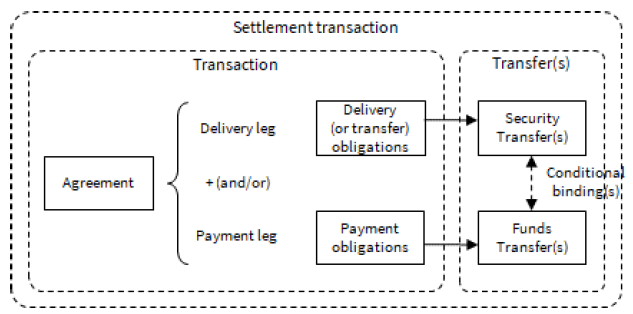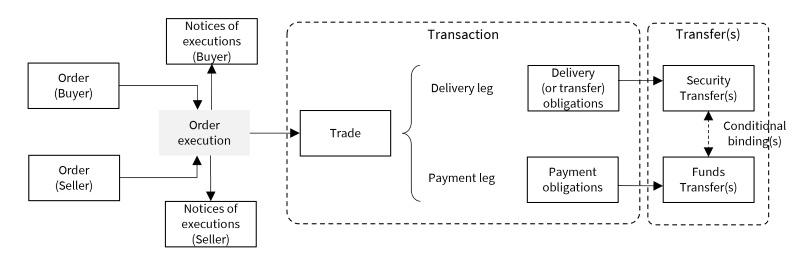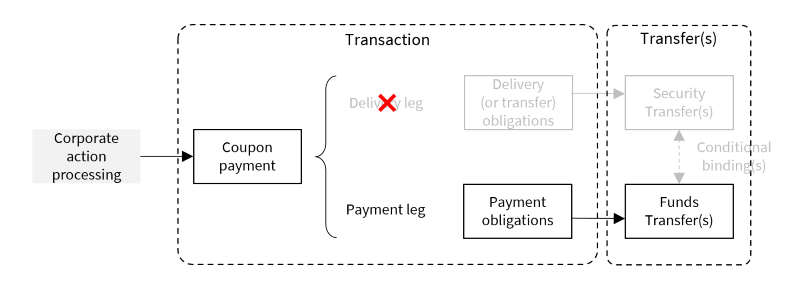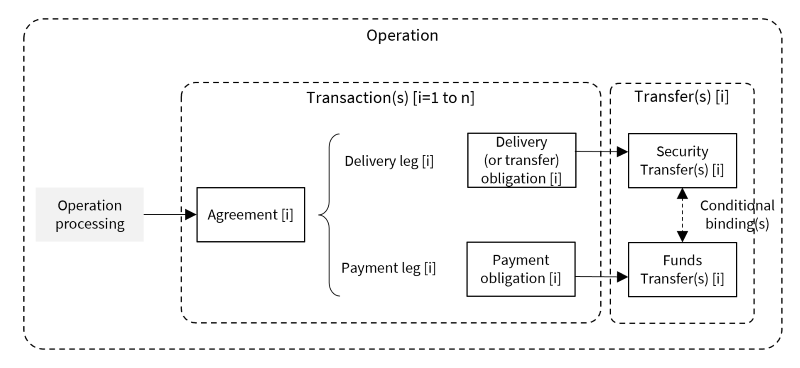The following focus presents a high-level perspective for the transaction management process applicable for primary and secondary markets. The aim is to maintain an operational management system which ensures an interoperability with the current existing post-trade systems.
A transaction is an agreement between parties to transfer Security Tokens from party A to party B, expressed in terms of delivery and/or payment obligations.
A delivery or transfer obligation refers to the obligation for a party (the sender) to transfer securities to its counterparty (the receiver).
A payment obligation refers to the obligation for a party (the sender) to transfer funds to its counterparty (the receiver).
The terms of the obligations are undetermined at the time of the transaction agreement.
A transaction can have none or many delivery obligations. The delivery leg refers to all delivery obligations related to a transaction.
A transaction can have none or many payment obligations. The payment leg refers to all payment obligations related to a transaction.
Both the delivery and the payment obligations are expressed in terms of transfers (either funds or securities) with conditional and/or unconditional bindings.
In order to settle a transaction, the parties involved must provide information on how to settle each obligation. The settlement instructions provide the required information (e.g. intermediaries, accounts, etc.) to settle obligations by determining the transfers to be performed.
The settlement instructions are sent to all participants involved in the settlement process. From the sender’s or the receiver’s perspective, settlement instructions can be categorized as delivery instructions or receipt instructions.
A settlement transaction refers to the combination of a transaction and all related transfers.

The settlement method refers to the method by which the obligations of a transaction are settled. It defines, if need be, the conditional processing between both the delivery and payment legs. For instance, the DvP settlement method states that the transfer of a security only happens after the payment is made.
Below are the most common settlement methods:
| Settlement method | Delivery leg | Payment leg |
|---|---|---|
| Delivery-versus-Payment (DvP) | ✓ (1 obligation) | ✓ (1 obligation) |
| Payment Free of Delivery (PFoD) | x | ✓ (1 obligation) |
| Delivery Free of Payment (DFoP) | ✓ (1 obligation) | x |
| Delivery-versus-Delivery (DvD) | ✓ (≥2 obligations) | x |
| Payment-versus-Payment (PvP) | x | ✓ (≥2 obligations) |
The settlement method has an impact on the way the settlement instructions are structured. Depending on the settlement method, the delivery, receipt, and payment instructions can be expressed separately or combined:
| Settlement method | Settlement instructions |
|---|---|
| Delivery-versus-Payment (DvP) | • Deliver versus Payment (DvP) instruction (e.g. Swift MT543) • Receive versus Payment (RvP) instruction (e.g. Swift MT541) |
| Delivery Free of Payment (DFoP) | • Deliver Free (DF) instruction (e.g. Swift MT542) • Receive Free (RF) instruction (e.g. Swift MT540) |
An indication of interest (IOI) is an underwriting expression showing a conditional, non-binding interest in buying a Security Token that is currently in registration.
An IOI is originated by an Investor (instructing party) and submitted by its dealer (executing party) during an issuance process. Once the issuance allocation step is performed, the IOI is converted into a subscription, which is a transaction/agreement to buy a security against payment. At the time of the agreement the security is generally not yet issued.

An order is an instruction to buy or sell a security.
Execution refers to the process by which the order is completed. Completion is reached by matching opposite orders. The details/terms of the execution are communicated to the parties involved through a notice of execution (NOE).
A trade is a transaction referring to the result of an order execution. An order execution can generate one or more trades.

A block trade is a high-volume trade, generally negotiated privately by execution parties (brokers/dealers) on behalf of a large number of instructing parties.
Trade allocation consists in splitting the block trade delivery and payment obligations across the instructing parties (which can in return split their obligations across their clients) for settlement.
As a consequence, a block trade transaction can result in one or many transactions, depending on the allocation mechanism used.

A corporate action is a voluntary, mandatory with choice, or mandatory corporate event that can bring a change to the related Security Token and/or its life cycle.
Some corporate actions such as a dividend or coupon payment may have a direct impact on Security Token holders. Such events will result in one or many transactions, generated during the processing of the corporate action.
For instance, a coupon payment results in as many payment transactions as there are security holders:

An operation refers to any event/process resulting in the generation of one or many transactions (and their related settlement transactions).

Below are some examples of operations:
| Operation | Transactions |
|---|---|
| Issuance | 1-to-n transactions (subscriptions) between the Issuer and subscribers |
| Trade | 1 transaction (trade) between the buyer and the seller |
| Coupon payment | • 1 transaction (coupon payment) between the Issuer and the Paying Agent • 1-to-n transactions (coupon payments) between the Paying Agent and the security holders • Conditional binding: the fund transfers between the Paying Agent and the Security Token holders are conditional on the fund transfer between the Issuer and the Paying Agent |
| Redemption | • 1-to-n transactions (redemptions) between the Security Token holders and the Issuers |